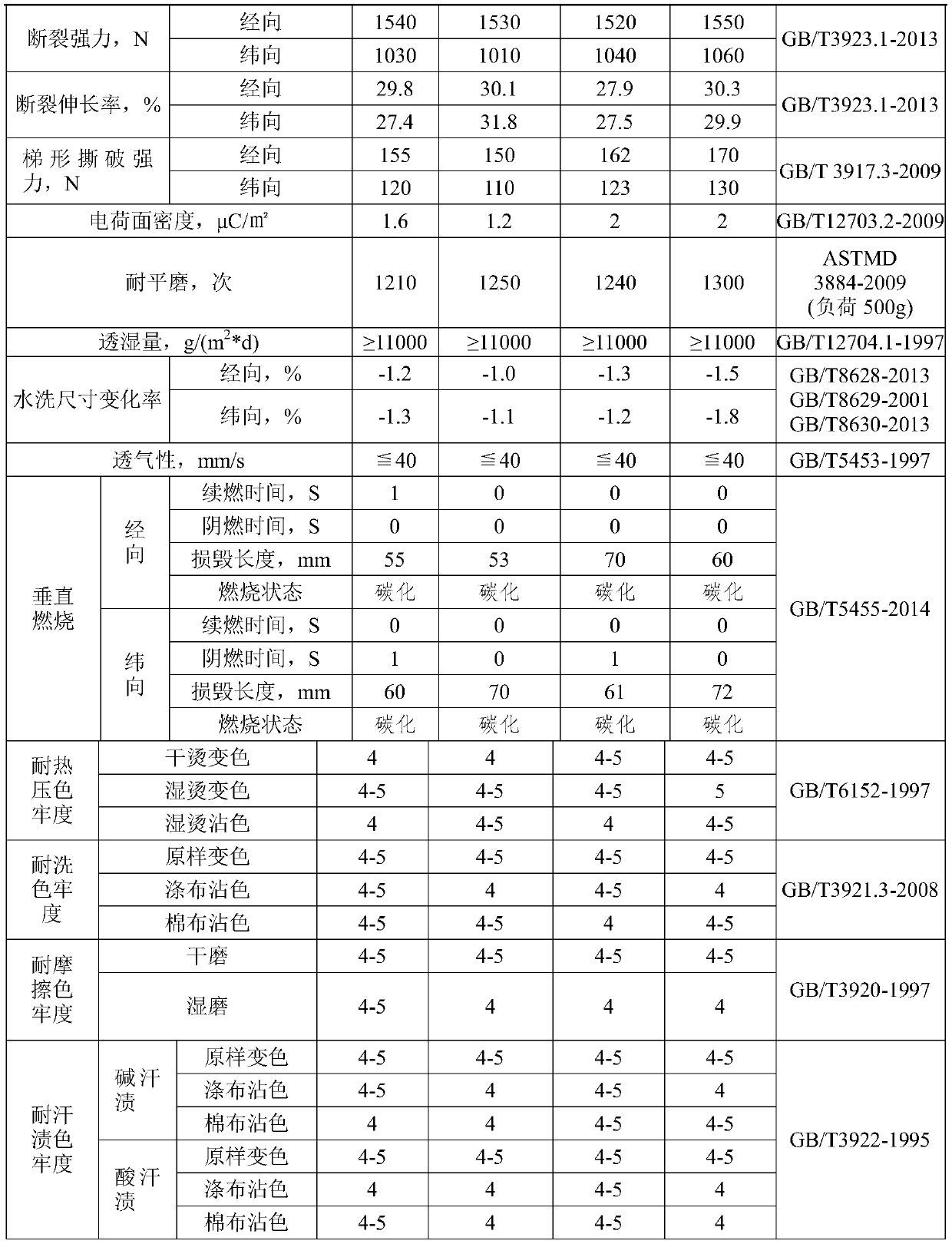Flame-retardant anti-molten-drop antistatic core-spun yarn and preparation method thereof
An anti-static and anti-droplet technology, applied in the direction of yarn, textiles and paper making, can solve the problems of high glass transition temperature, poor durability and difficult dyeing of aramid fiber, and achieve good yarn quality, simple process and easy dyeing Effect
- Summary
- Abstract
- Description
- Claims
- Application Information
AI Technical Summary
Problems solved by technology
Method used
Image
Examples
Embodiment 1
[0039] Example 1. Preparation of flame-retardant anti-melt dripping anti-static fabric 1
[0040] 1) The first step of fiber mixing: 20% aramid fiber (of which aramid 1414 fiber accounts for 60%), flame-retardant viscose fiber (FR fiber provided by Austrian Lenzing Company) 53% and organic conductive fiber (Nakabo, Japan) Conductive fiber provided by the company) 2% mixed evenly for use;
[0041] 2) The second step of mixing nylon filaments: Combine 25% of flame-retardant nylon 66 filaments with a phosphorus content of 4000ppm and a strength of 5cN / dtex and 2% of high-strength non-flame-retardant nylon 6 filaments with a strength of 7cN / dtex. Mix the strips evenly and set aside;
[0042] 3) Spinning in the third step: carding, drawing, second drawing, tertiary drawing, roving of the mixed fiber, and then mixing with the nylon filament in the second step for core spinning spun yarn; Process to obtain the blended core-spun yarn used for combat fabrics, and then weave. Among them, th...
Embodiment 2
[0043] Example 2. Preparation of flame-retardant anti-melt dripping anti-static fabric 2
[0044] 1) The first step of fiber mixing: 17% aramid fiber (of which aramid 1414 fiber accounts for 80%), flame-retardant viscose fiber (FR fiber provided by Austrian Lenzing Company) 61% and organic conductive fiber (Nakabo Conductive fiber provided by the company) 1% mixed evenly for use;
[0045] 2) The second step of mixing nylon filaments: mix the flame-retardant nylon 66 filament with a phosphorus content of 6000ppm and a strength of 3.5cN / dtex at 18% and a high-strength non-flame retardant nylon 66 filament with a strength of 8cN / dtex at 3%. Draw and mix evenly for use;
[0046] 3) Spinning in the third step: carding, drawing, second drawing, tertiary drawing, roving of the mixed fiber, and then mixing with the nylon filament in the second step for core spinning spun yarn; Process to obtain the blended core-spun yarn used for combat fabrics, and then weave. Among them, the delivery sp...
Embodiment 3
[0047] Example 3. Preparation of flame-retardant anti-melt dripping anti-static fabric 3
[0048] 1) The first step of fiber mixing: 18% aramid fiber (of which aramid 1414 fiber accounts for 100%), flame-retardant viscose fiber (FR fiber provided by Austrian Lenzing Company) 61% and organic conductive fiber (Nakabo Conductive fiber provided by the company) 1% mixed evenly for use;
[0049] 2) The second step of mixing nylon filaments: Combine 18% of flame-retardant nylon 66 filaments with a phosphorus content of 4500ppm and a strength of 4cN / dtex and 2% of high-strength non-flame-retardant nylon 66 filaments with a strength of 8cN / dtex. Mix the strips evenly and set aside;
[0050] 3) Spinning in the third step: carding, drawing, second drawing, tertiary drawing, roving of the mixed fiber, and then mixing with the nylon filament in the second step for core spinning spun yarn; Process to obtain the blended core-spun yarn used for combat fabrics, and then weave. Among them, the deli...
PUM
| Property | Measurement | Unit |
|---|---|---|
| Torsion | aaaaa | aaaaa |
| length | aaaaa | aaaaa |
| strength | aaaaa | aaaaa |
Abstract
Description
Claims
Application Information
 Login to View More
Login to View More - R&D
- Intellectual Property
- Life Sciences
- Materials
- Tech Scout
- Unparalleled Data Quality
- Higher Quality Content
- 60% Fewer Hallucinations
Browse by: Latest US Patents, China's latest patents, Technical Efficacy Thesaurus, Application Domain, Technology Topic, Popular Technical Reports.
© 2025 PatSnap. All rights reserved.Legal|Privacy policy|Modern Slavery Act Transparency Statement|Sitemap|About US| Contact US: help@patsnap.com



